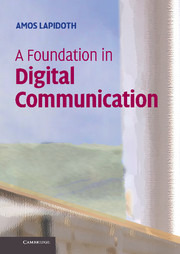Book contents
- Frontmatter
- Contents
- Preface
- Acknowledgments
- 1 Some Essential Notation
- 2 Signals, Integrals, and Sets of Measure Zero
- 3 The Inner Product
- 4 The Space L2 of Energy-Limited Signals
- 5 Convolutions and Filters
- 6 The Frequency Response of Filters and Bandlimited Signals
- 7 Passband Signals and Their Representation
- 8 Complete Orthonormal Systems and the Sampling Theorem
- 9 Sampling Real Passband Signals
- 10 Mapping Bits to Waveforms
- 11 Nyquist's Criterion
- 12 Stochastic Processes: Definition
- 13 Stationary Discrete-Time Stochastic Processes
- 14 Energy and Power in PAM
- 15 Operational Power Spectral Density
- 16 Quadrature Amplitude Modulation
- 17 Complex Random Variables and Processes
- 18 Energy, Power, and PSD in QAM
- 19 The Univariate Gaussian Distribution
- 20 Binary Hypothesis Testing
- 21 Multi-Hypothesis Testing
- 22 Sufficient Statistics
- 23 The Multivariate Gaussian Distribution
- 24 Complex Gaussians and Circular Symmetry
- 25 Continuous-Time Stochastic Processes
- 26 Detection in White Gaussian Noise
- 27 Noncoherent Detection and Nuisance Parameters
- 28 Detecting PAM and QAM Signals in White Gaussian Noise
- 29 Linear Binary Block Codes with Antipodal Signaling
- A On the Fourier Series
- Bibliography
- Theorems Referenced by Name
- Abbreviations
- List of Symbols
- Index
10 - Mapping Bits to Waveforms
Published online by Cambridge University Press: 05 June 2012
- Frontmatter
- Contents
- Preface
- Acknowledgments
- 1 Some Essential Notation
- 2 Signals, Integrals, and Sets of Measure Zero
- 3 The Inner Product
- 4 The Space L2 of Energy-Limited Signals
- 5 Convolutions and Filters
- 6 The Frequency Response of Filters and Bandlimited Signals
- 7 Passband Signals and Their Representation
- 8 Complete Orthonormal Systems and the Sampling Theorem
- 9 Sampling Real Passband Signals
- 10 Mapping Bits to Waveforms
- 11 Nyquist's Criterion
- 12 Stochastic Processes: Definition
- 13 Stationary Discrete-Time Stochastic Processes
- 14 Energy and Power in PAM
- 15 Operational Power Spectral Density
- 16 Quadrature Amplitude Modulation
- 17 Complex Random Variables and Processes
- 18 Energy, Power, and PSD in QAM
- 19 The Univariate Gaussian Distribution
- 20 Binary Hypothesis Testing
- 21 Multi-Hypothesis Testing
- 22 Sufficient Statistics
- 23 The Multivariate Gaussian Distribution
- 24 Complex Gaussians and Circular Symmetry
- 25 Continuous-Time Stochastic Processes
- 26 Detection in White Gaussian Noise
- 27 Noncoherent Detection and Nuisance Parameters
- 28 Detecting PAM and QAM Signals in White Gaussian Noise
- 29 Linear Binary Block Codes with Antipodal Signaling
- A On the Fourier Series
- Bibliography
- Theorems Referenced by Name
- Abbreviations
- List of Symbols
- Index
Summary
What Is Modulation?
Data bits are mathematical entities that have no physical attributes. To send them over a channel, one needs to first map them into some physical signal, which is then “fed” into a channel to produce a physical signal at the channel's output. For example, when we send data over a telephone line, the data bits are first converted to an electrical signal, which then influences the voltage measured at the other end of the line. (We use the term “influences” because the signal measured at the other end of the line is usually not identical to the channel input: it is typically attenuated and also corrupted by thermal noise and other distortions introduced by various conversions in the telephone exchange system.) Similarly, in a wireless system, the data bits are mapped to an electromagnetic wave that then influences the electromagnetic field measured at the receiver antenna. In magnetic recording, data bits are written onto a magnetic medium by a mapping that maps them to a magnetization pattern, which is then measured (with some distortion and some noise) by the magnetic head at some later time when the data are read.
In the first example the bits are mapped to continuous-time waveforms corresponding to the voltage across an impedance, whereas in the last example the bits are mapped to a spatial waveform corresponding to different magnetizations at different locations across the magnetic medium. While some of the theory we shall develop holds for both cases, we shall focus here mainly on channels of the former type, where the channel input signal is some function of time rather than space.
- Type
- Chapter
- Information
- A Foundation in Digital Communication , pp. 169 - 184Publisher: Cambridge University PressPrint publication year: 2009



